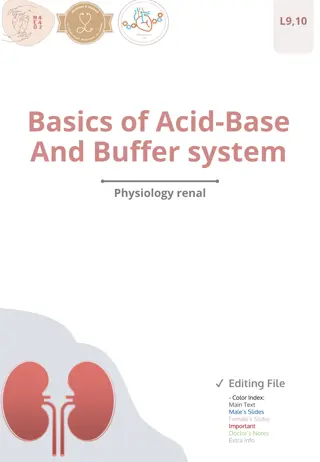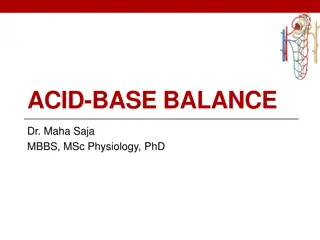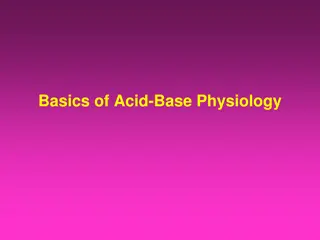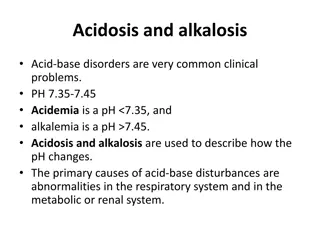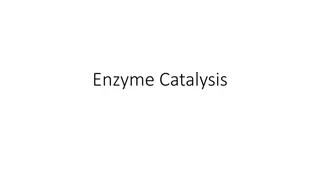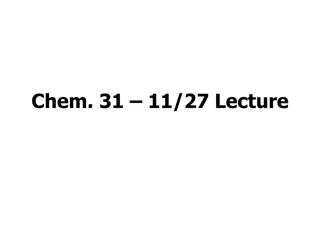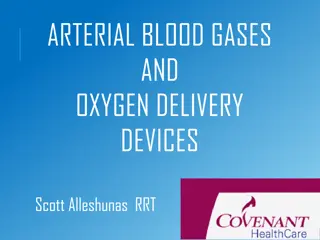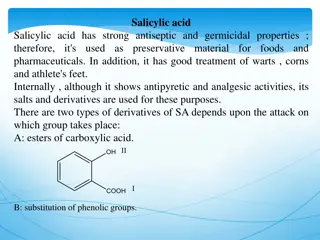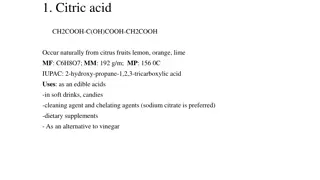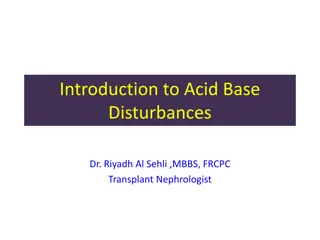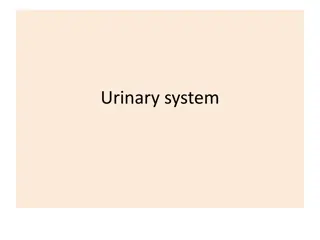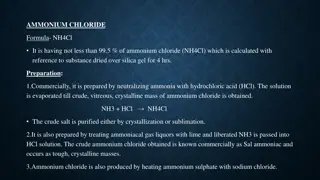Understanding Acid-Base Balance in Patients
Explore the assessment and care of patients with acid-base imbalances, including the importance of normal blood pH levels, the role of acids and bases in body chemistry, and the calculation of free hydrogen ion levels. Discover how acid-base balance is maintained and the critical impact of pH changes on bodily functions.
Download Presentation

Please find below an Image/Link to download the presentation.
The content on the website is provided AS IS for your information and personal use only. It may not be sold, licensed, or shared on other websites without obtaining consent from the author. Download presentation by click this link. If you encounter any issues during the download, it is possible that the publisher has removed the file from their server.
E N D
Presentation Transcript
Chapter 14 Assessment and Care of Patients with Acid Base Imbalances
Acid/Base Balances Occurs through control of hydrogen ion production & elimination. Body fluid pH measures free hydrogen ion levels. Normal pH is: Arterial: 7.35 to 7.45 Venous: 7.31 to 7.41 pH < 6.9 or > 7.8 is usually fatal. 2
Normal Blood pH Changes from normal blood pH (7.35 to 7.45) interfere with many normal functions by: Changing the shape & reducing the function of hormones and enzymes (so that they may no longer perform their normal functions) Changing the distribution of other electrolytes, causing fluid and electrolyte imbalances Altering the responses of excitable membranes Making the heart, nerves, muscles, & GI tract either less or more active Decreasing the effectiveness of many drugs ( 3
Acid-Base Balance Acid-base balance occurs by matching the rate of hydrogen ion production with hydrogen ion loss. 4
Acids Base Chemistry Acids are substances that release hydrogen ions when dissolved in water. It increases the amount of hydrogen ions in the solution. Acidic liquids range in pH from 1.0-6.99 (Low pH) the most common acid is carbonic acid : H2CO3 Carbon dioxide + water = carbonic acid [carbon dioxide+ water = carbonic acid >breaks down into > Hydrogen+ Bicarbonate] [CO2 + H2O = H2CO3 > breaks down into > H + HCO3] - Lungs (CO2) Bases are substances that binds free hydrogen ions in solution-they are hydrogen acceptors that reduce the amount of free hydrogen ions in solutions. Basic liquids range in pH from 7.01-14.0 (High ph) The most common base is bicarbonate : HCO3 NOTE: Constant ratio of 1 carbonic acid to 20 Bicarbonate. Fig 14-4 - Kidneys (bicarbonate) Buffers can either release a hydrogen ion into a fluid or bind a hydrogen ion from a fluid. It acts as it needs to based on existing acid-base balance. Buffers dissolved in water can react in two ways: either as an acid (releasing a hydrogen ion) or as a base (binding a hydrogen ion). Buffers are important in keeping body fluid pH in the normal range Neutral liquids have a pH of 7.0 (Neutral pH) 5
Calculation of Free Hydrogen Ion Level The pH is a calculation of the free hydrogen ion level in body fluids. The pH calculations come from an equation that shows how three factors are related: the level of free hydrogen ions (pH), (increased CO2 = more free hydrogen ions) the amount of bases (always stays at 1:20 ratio), and the strength of acids in a solution (amount of CO2) GIVEN: 1:20 ratio of Carbonic Acid to Bicarbonate ONLY factor that changes (in equation) is the CO2 level Whenever CO2 level changes, the pH level changes in the OPPOSITE direction Whenever HCO3 level changes, the pH level changes in the SAME direction 6
Sources of Acids Glucose metabolism Fat and protein metabolism Incomplete metabolism of glucose and fats Destruction of cells 7
ACID-BASE REGULATORY MECHANISMS Our body homeostasis depends on three factors: Hydrogen ion production is consistent and not excessive. CO2 loss from the body through breathing keeps pace with hydrogen ion production. The ratio between carbonic acid and bicarbonate remains at 1:20. 8
Normal Parameters pH PaC02 35-45 mm H HC03 21-28 mEq/L 7.35-7.45 Per Cent of Hydrogen Paco2, Partial pressure of arterial carbon dioxide; Pao2, Partial pressure of arterial oxygen. Chart 14-1 pH < 6.9 or > 7.8 is usually fatal. 9
ABGs Step 1: Check pH Step 2: Determine pC02 Step 3: Watch the Bicarbonate Step 4: Look for Compensation Step 5: Determine Pao2 and Sao2 10
Lets Do Some ABG interpretation pH PC02 HC03 16 mEq/L 7.30 25 mm Hg 11
Lets try another! pH PC02 HC03 24 mEq/L 7.52 30 mm HG 12
One more! pH PC02 HC03 37 mEq/L 7.53 41 mm Hg 13
Last one pH PC02 HC03 39 mEq/L 7.38 70 mm Hg 14
Defense Lines Buffers 1st Respiratory - 2nd Kidneys 3rd 15
Defense Lines Buffers 1st line of defense against free hydrogen ions Always present in body fluids Job is to reduce or raise H+ to normal levels Bind or release H+ as needed Chemical Buffers Paired base & acid: Bicarbonate (ECF & ICF) & phosphate (ICF) Protein Buffers Bind or release H+ as needed ECF: albumin & globulins Major ICF buffer: Hemoglobin 16
Respiratory Acid-Base Control Mechanisms When chemical buffers alone cannot prevent changes in blood pH, the respiratory system is the second line of defense against changes. Hyperventilation Hypoventilation 17
Renal Acid-Base Control Mechanisms The kidneys are the third line of defense against wide changes in body fluid pH. Kidney movement of bicarbonate Formation of acids Formation of ammonium 18
Compensation The body attempts to correct changes in blood pH. pH < 6.9 or > 7.8 is usually fatal. Respiratory system is sensitive to acid- base changes; can begin compensation efforts within seconds. Renal compensatory mechanisms are much more powerful and result in rapid changes in ECF composition. 19
Respiratory Compensation Lungs compensate for acid-base imbalances of a metabolic origin. Example prolonged running causes buildup of lactic acid, hydrogen ion levels in the ECF increase, pH drops; breathing is triggered in response to the increased carbon dioxide levels to bring the pH level back to normal. 20
Renal Compensation A healthy kidney can correct or compensate for changes in blood pH when the respiratory system is either overwhelmed or is not healthy. (Continued) 21
Renal Compensation(Continued) Example person has chronic obstructive pulmonary disease, retains carbon dioxide in the blood, blood pH level falls (becomes more acidic); kidney excretes more hydrogen ions and increases the reabsorption of bicarbonate back into the blood. 22
Assessment of Acid-Base Balance History Physical assessment Diagnostic assessment 23
Acidosis Arterial blood pH level < 7.35 Can be caused by metabolic problems, respiratory problems, or both Clients at greatest risk for acute acidosis: those with problems that impair breathing Major changes in body function: an increase in hydrogen ions creates imbalances of electrolytes, especially potassium 24
Metabolic Acidosis Overproduction of hydrogen ions Underelimination of hydrogen ions Underproduction of bicarbonate ions Overelimination of bicarbonate ions 25
Respiratory Acidosis Respiratory acidosis results from: Impaired respiratory function that reduces the exchange of oxygen and carbon dioxide Retention of carbon dioxide that causes increased production of free hydrogen ions 26
Causes of Respiratory Acidosis Respiratory depression Chemical depression Physical depression Inadequate chest expansion Skeletal problems Respiratory muscle weakness External conditions Airway obstruction Reduced alveolar-capillary diffus(Continued) 27
Assessment History Physical assessment/clinical manifestations Central nervous system Neuromuscular Cardiovascular Respiratory (Kussmaul respiration) Skin (Continued) 28
Assessment (Continued) Psychosocial assessment Laboratory assessment Metabolic acidosis Respiratory acidosis 29
Interventions for Acidosis Correct the underlying problem. Increase aerobic metabolism. Monitor for changes. O2, Meds, Patent Airway 30
Interventions for Metabolic Acidosis Hydration Drugs to control or treat the problem causing the acidosis Respiratory acidosis maintain a patent airway and enhance gas exchange Drug therapy to increase airway diameter and to thin pulmonary secretions Oxygen therapy, pulmonary hygiene, ventilation support 31
Alkalosis Arterial blood pH is > 7.45. Acid-base balance of the blood is disturbed by an excess of bases, especially bicarbonate. Problems of alkalosis are serious and potentially life threatening. 32
Metabolic Alkalosis Base excess results from excessive intake of bicarbonates, carbonates, acetates, citrates, and lactates. Acid deficit is caused by disease processes or medical treatments, or by prolonged vomiting, excess cortisol, or hyperaldosteronism. 33
Metabolic Alkalosis The hallmark is an increased bicarbonate level with a rising partial pressure of arterial carbon dioxide. Serum potassium level decreases. Calcium binding increases and hypocalcemia results. Most of the serious problems are caused by the resulting hypocalcemia. 34
Respiratory Alkalosis Excessive loss of carbon dioxide through hyperventilation Anxiety, fear, or improper settings on mechanical ventilators causing hyperventilation Direct stimulation of central respiratory center from fever, metabolic acidosis, central nervous system lesions, and drugs, also causing hyperventilation 35
Respiratory Alkalosis Classic profile: Reduced bicarbonate level Low pressure of arterial carbon dioxide Low serum potassium level Low serum calcium level Manifestations: Chart 14-6 36
NCLEX-RN Prep Which of the following arterial blood gases would the nurse expect to see when a client has apnea and develops acidosis? A. pH 7.42, PaCO2 48mmHg, HCO3 25 mEq/l B. pH 7.29, PaCO2 62mmHg, HCO3 23 mEq/l C. pH 7.36, PaCO2 42mmHg, HCO3 26 mEq/l D. pH 7.49, PaCO2 30mmHg, HCO3 35 mEq/l 37
NCLEX-RN Prep Rational: B; apnea and hypoventilation results in rising carbon dioxide levels, which lead to acidosis. The ABG would likely reflect resp. acidosis without compensation. 38
NCLEX-RN Prep What action should the nurse take initially to avoid acid-base imbalances when a client becomes anxious and starts to hyperventilate? A. tell the client to stop breathing so fast b/c he may pass out. B. give the client a sedative to decrease anxiety and stop hyperventilation. C. Give the client a paper bag to breathe into. D. Notify the physician 39
NCLEX-RN Prep Rational: C; this prevents the CO2 level from decreasing and rebreathing the gas in the bag will also help to decrease the respiratory rate. Sedatives would not be your first line of defense. First response will probably not decrease anxiety. Contacting the physician may be needed but the first nursing action is the paper bag. 40
Creative Commons License This work is licensed under a Creative Commons Attribution 4.0 International License. Except where otherwise noted, this content by Southern Regional Technical College is licensed under the Creative Commons Attribution 4.0 International License. To view a copy of this license, click https://creativecommons.org/licenses/by/4.0/ Healthcare Careers Work!(HCW) is sponsored by a $2.3 million grant from the U.S. Department of Labor, Employment & Training Administration. TAACCCT Grant #TC- 26488-14-60-A-13. Southern Regional Technical College is an equal opportunity employer and will make adaptive equipment available to persons with disabilities upon request. This workforce product was funded by a grant awarded by the U.S. Department of Labor s Employment and Training Administration. The product was created by the grantee and does not necessarily reflect the official position of the U.S. Department of Labor. The U.S. Department of Labor makes no guarantees, warranties, or assurances of any kind, express or implied, with respect to such information, including any information on linked sites and including, but not limited to, accuracy of the information or its completeness, timeliness, usefulness, adequacy, continued availability, or ownership.


